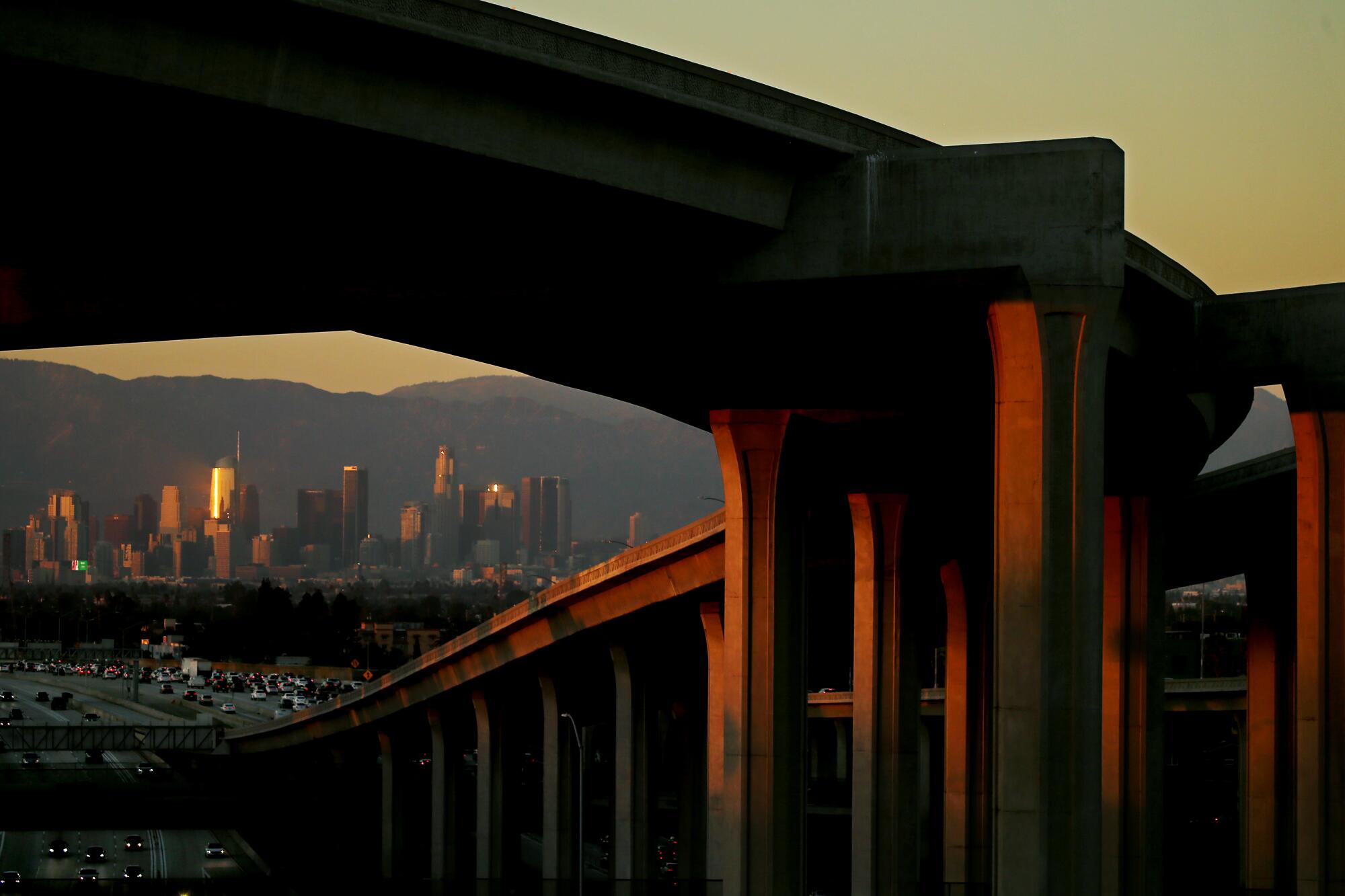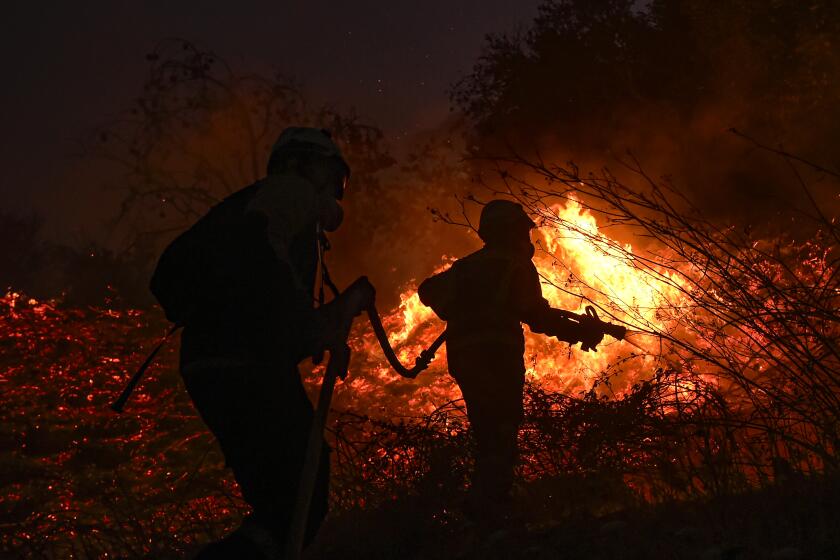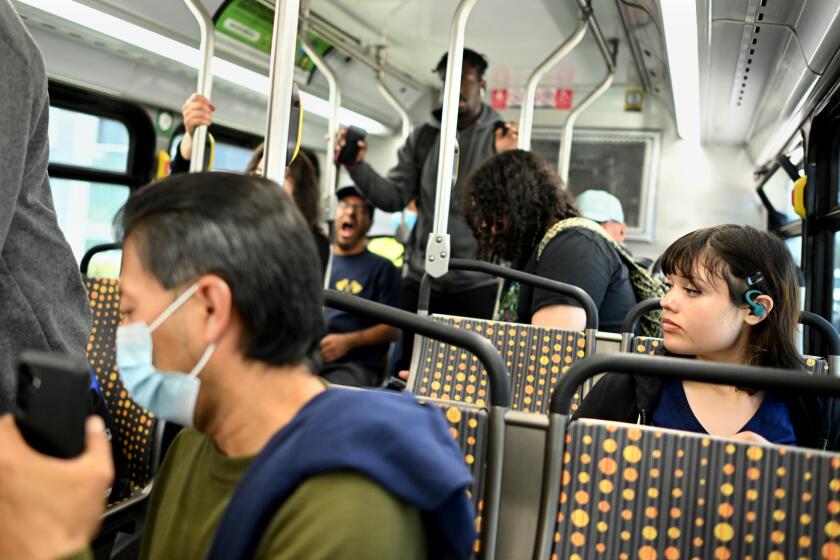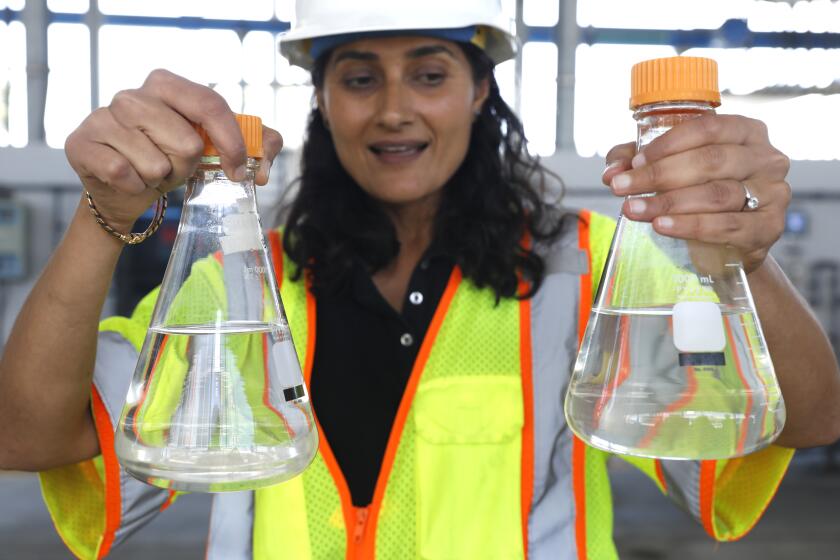
- Share via
In the wake of the world’s hottest summer on record, Los Angeles City Controller Kenneth Mejia is calling for an urgent reboot of the city’s “Green New Deal” over concerns that the 2019 climate plan has outlived its usefulness and lacks the transparency needed to accurately measure its outcomes.
The plan laid out a sweeping vision of a more sustainable Los Angeles when it was first unveiled four years ago by former Mayor Eric Garcetti. It included 47 long-term sustainability targets and 97 short-term milestones geared toward improving air quality, reducing emissions, increasing water supplies and moving toward 100% renewable energy, among other goals.

But in a report this week, Mejia said the plan lacked specifics and that its most recent progress report offered little in the way of meaningful metrics.
“The Green New Deal contains a mix of inputs and outputs, but there are very few measurable outcomes directly related to climate change, or even environmental sustainability more broadly,” the report says.
Aggressive and impactful reporting on climate change, the environment, health and science.
The Green New Deal’s most recent progress report in May 2022 assigned only four possible grades to climate targets — ranking them from “making progress” to “milestone exceeded” — and mostly inventoried short-term goals, the controller found. Nearly half of those targets had been achieved or exceeded, but 39 were lagging and nine were on track.
Some goals were too vague to measure, such as creating 100,000 green jobs by 2025 but not defining what qualifies as a “green job,” the report says.
“Given what former Mayor Garcetti described as ‘the existential threat of climate change,’ the small number of outcomes in the Green New Deal fall short of a comprehensive and actionable set of steps to reduce greenhouse gas emissions, the primary driver of climate change,” it says.
In an interview, Mejia and members of his team said their intention in analyzing the Green New Deal was not to second-guess L.A.’s achievements so far, but to work with city departments, the public and Mayor Karen Bass to build on the progress to date.
“Our sense of best practices is less that you produce a glittering document that everyone stands back and claps for, but rather that there be a coordinated effort, and that there be a clear set of measurable outcomes that we track for the public to see what’s working, and to do more of what’s working and less of what’s not,” said Rick Cole, chief deputy controller.
The original plan was “not ambitious enough, especially considering that we do have seven to 10 years to avoid climate catastrophe,” Mejia said.
Global surface temperatures last month were 2.25 degrees above the 20th century average of 60.1 degrees, surpassing the record set in August 2016.
Among the Green New Deal’s bolder targets is to reduce the number of vehicle miles traveled per capita by at least 13% by 2025, with that number increasing to 45% by 2050. Transportation is the state’s largest contributor to greenhouse gas emissions, according to the California Air Resources Board.
But the 2022 progress report didn’t track those numbers at all, instead focusing more on efforts to electrify vehicles, the analysis says. The Green New Deal also lacks any milestones focused on expanding public transit as a way of reducing car dependency.
Officials in the mayor’s office acknowledged that more could be done but pointed to ongoing transit expansion projects and funding from measures M and R as examples of progress in that sector.
“We thank the Controller for issuing a report — much of what was released today is aligned with the Mayor’s climate platform and the goals of the Mayor’s Office of Energy and Sustainability and we look forward to locking arms with any willing partners ready to take action on this important issue,” read a statement from Zach Seidl, deputy mayor of communications.

Antonio Bento, a professor of public policy and economics at USC, said Mejia’s analysis was perfectly timed.
“The controller’s report is correct in pointing out that with a new mayor in town, we have an opportunity to go back to the original report and take a critical look at what has been accomplished and what has not been accomplished, but also to think a little bit about objective metrics to evaluate the different targets,” he said.
Bento said he does not fault the original Green New Deal for laying out a broad vision, likening it to a “letter of intent” that was more focused on getting stakeholders on board. But it also over-emphasized mitigating climate change rather than adapting to it, he said.
“As a consequence, we are now faced with quite regular heat waves, and we are starting to see the impacts of heat waves in our communities — in particular, in relatively low-income communities and communities of color — and unfortunately, the progress we have made in those communities to promote any kind of adaptation has indeed fallen behind.”
Transportation is the largest sector of planet-warming gases, yet Americans won’t let go of their cars. Autos can mean freedom, but so can leaving them behind.
There are examples of well-constructed targets in the Green New Deal, however. That includes the goal to source 70% of the city’s water locally by 2035, and to build at least 10 new multi-benefit stormwater capture projects by 2025. Those are “definitive, knowable” targets against which the city can easily demonstrate its progress, the report says.
The controller similarly lauded the city’s progress on transitioning its power grid from 40% coal and 20% renewable energy sources in 2013 to 36% renewable and 13% coal in 2022, but said meticulous, real-time tracking will be needed to reach its future goal of 100% renewables by 2045.
“The more data we put out — the more data policymakers have to work with, and for the public to see and to have those debates — the more we can actually move toward whatever goal we’re trying to achieve,” Mejia said.
The Green New Deal also does a good job of highlighting environmental justice issues and the disproportionate burdens that lower-income communities face when it comes to pollution, heat and other climate hazards. But it lacks quantified goals to measure success against such challenges.
One example would be better tracking of emergency room visits for childhood asthma, said Michael Shear, director of research and government affairs with the controller’s office. “We might be doing a great job with that, or we might be doing a great job with that in certain places and we need to replicate it,” he said. “That’s the kind of tracking we’re talking about.”
Tracking the number and locations of active oil wells, as well as the quantity of oil pumped and the estimated amount of oil remaining in the ground, is another example, Mejia said, especially since many wells are located in those communities.
The effects of global warming will inevitably unfold over the next two to three decades, experts say. What happens beyond that depends on actions today.
The analysis offered a number of recommendations to improve the Green New Deal, including bolder targets for renewable energy, housing and the reduction of cars. Last year, California regulators passed an historic ban on the sale of new gasoline-powered cars and trucks in the state by 2035.
Bento, of USC, said Los Angeles is making gains toward electric vehicles and charging stations, “but we have forgotten to ask ourselves, ‘Don’t we also want to get a non-trivial amount of people away from cars altogether?’ And if so, that requires having very specific targets and goals for increased public transit.”
Mejia’s report recommends a continued focus on transit-oriented development — where most needs can be met within a 15-minute walk, bike or transit trip — and notes that “[electric vehicles] are the future of cars, but cars cannot be our future.”

Bento also highlighted some of the Green New Deal’s energy targets, including plans to convert all buildings to net-zero carbon by 2050, which would effectively require every household and building owner to replace all gas-powered systems and appliances with cleaner ones.
Such a goal may be achievable, he said, but the city is also influenced by what the federal government can or cannot provide — including funds available through President Biden’s landmark climate bill, the Inflation Reduction Act, to support programs for increased energy efficiency.
He said it is imperative for L.A. to align its most urgent priorities with IRA funds that are currently available, “because you don’t even know, come 2024, if you’re going to continue to have a Democratic president.”
In the face of dire drought, cities and water agencies are now investing heavily in large-scale wastewater recycling facilities.
The city is going after federal funding as it becomes available, including recent applications from the Los Angeles Department of Water and Power and the Port of Los Angeles for projects to help with decarbonization efforts, according to the mayor’s office.
The city is also working with L.A. County and other groups to put together a regional climate action plan, and will continue to collaborate closely with agencies such as the L.A. Planning Department and the Climate Emergency Mobilization Office, which have committed to creating various heat plans and climate assessments.
“Building on the success announced thus far, Mayor Bass will continue to lead Los Angeles to a new era of sustainability that supports front-line communities while making major investments in energy efficiency while creating good-paying jobs in the process,” Seidl’s statement said.
Bass’s office also pointed to recent DWP projects geared toward energy efficiency in multi-family units, as well as expanded turf replacement programs, as examples of other efforts already underway.

But as the city grapples with more extreme weather driven by climate change — including drought, flooding, heat and even a tropical storm — many of its poorest residents will continue to bear the brunt. Mejia said a proposed initiative to require air conditioning in all rental properties could make a material difference.
The controller and his team noted that climate action plans in other major cities show many of the same strengths and weaknesses as those of Los Angeles.
Plans from San Francisco, Denver, Seattle, Boston and New York set similarly ambitious long-term targets and aspirational goals, but are not significantly better or clearer than L.A.’s, they said. However, there are individual lessons from each city that could be studied and applied here, such as more consistent goal tracking exemplified by New York City.
The team also hoped Los Angeles could be a model for other cities moving forward.
“The whole goal is to move the needle, because we’re not going to solve climate change in 465 square miles,” Cole said. “But the consistent theme of this is that we should be A) a leader, and B) an example.”














